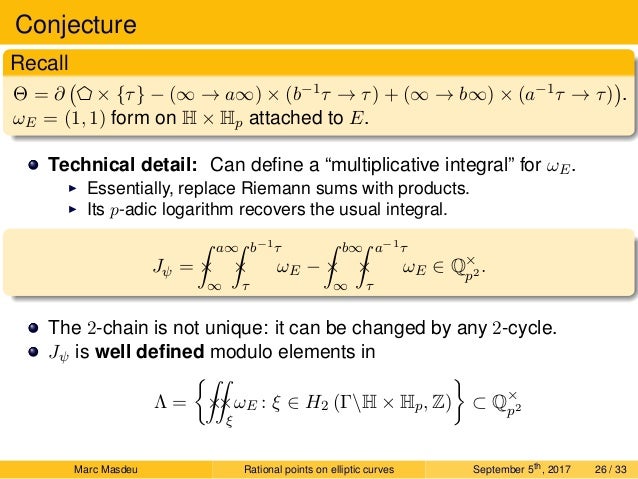In the realm of algebraic geometry, elliptic curves stand as multifaceted entities whose beauty and complexity invite both admiration and rigorous study. Imagine an intricate tapestry woven from the threads of number theory and geometry, where each point represents a delicate balance of mathematical principles. To delve into the world of rational points on elliptic curves is to embark on a journey through a landscape rich with intellectual challenges and profound revelations.
An elliptic curve is defined by an equation of the form:
y² = x³ + ax + b
where the discriminant Δ (Delta) is non-zero to ensure that the curve has no singularities—no cusps or self-intersections. These curves serve as a bridge between pure mathematics and applied fields, notably in cryptography, where the security of algorithms relies on the obscure nature of these rational points. Defined over a field, typically the rational numbers (ℚ), we are tasked with finding solutions (x, y) that yield rational coordinates—a quest as elusive as finding a needle in a haystack.
The initial foray into identifying rational points is often akin to casting a wide net into a vast ocean. A systematic method to achieve this is the heuristic approach. It begins with a foundational understanding of the curve’s structure. One can analyze the points at infinity, which often act as a guiding star in the pursuit of rational coordinates. For an elliptic curve defined over ℚ, one key instance is the point at infinity, denoted O, which serves as a symbiotic partner in the group law defined on the curve. Herein lies the first significant revelation: rational coordinates do not exist in isolation. Rather, they are interconnected through a principle of group operations.
Next, we explore the notion of symmetry inherent in elliptic curves. Introducing the Weierstrass form elucidates potential patterns in rational solutions, while geometric interpretations can reveal symmetries that hint at where rational points could reside. Perhaps the most analytical method to tackle the problem is through the use of descent methods, a process of backtracking through relationships between points. This involves reducing the dimensionality of the problem, often leveraging known rational points to generate new ones through a series of calculations.
A frequently employed strategy is the examination of torsion points— points of finite order that can be derived through repetitious addition of a specific rational point to itself. Torsion points manifest as a finite subgroup of the elliptic curve and can provide vital clues as one seeks a richer set of rational coordinates. By identifying these points through a cycle of addition, one can systematically generate further candidates for rational points.
Moreover, the Lutz-Nagell theorem offers significant insights into the nature of rational points on elliptic curves of the form y² = x³ + k, specifically with integer coefficients. This theorem states that if there exists a rational point (x, y), where y is even, then x must be an integer. Furthermore, if the x-coordinate is odd, it opens up a landscape of possibilities but is likewise tempered by limitations imposed by the values of k. Such constraints forge pathways through which one can navigate the labyrinth of rational points.
After the initial search, the utilization of rational structures like the Mordell-Weil theorem comes into play. This theorem affirms that the group of rational points on an elliptic curve is finitely generated. This notion incites an exploration of rank, a measure of the curve’s richness in terms of rational points. The rank can be determined, albeit through intricate calculations involving infinite descent methods, which demand both tenacity and ingenuity from the mathematician.
For those equipped with computational tools, leveraging techniques such as the Chabauty-Coleman method can usher one closer to revelations about the rational points on specific classes of curves. This method relies on the integration of p-adic analysis to restrict the space of possible rational points, particularly effective when the rank is lower than the dimension of the curve. This marriage of number theoretic ideals and computational prowess introduces a modern dimension to the quest for rational points.
A profound milestone in the journey of understanding rational points on elliptic curves manifests through the Langlands program, a series of interconnected conjectures and formulations that aim to bridge various fields of mathematics. The Langlands correspondence posits a tantalizing interplay between elliptic curves and modular forms. By establishing connections between these seemingly disparate realms, the pathways leading to rational points broaden and deepen, enriching the overall narrative of number theory.
In conclusion, the pursuit of rational points on elliptic curves unveils an intricate interplay of mathematical constructs—a world peppered with symmetries, structures, and interconnectedness. This exploration, characterized by both analytical rigor and philosophical depth, challenges the intellect while offering glimpses into the profound beauty of mathematics. As one navigates this landscape, the rational points emerge not merely as isolated numerical curiosities but as integral elements of a grander mathematical symphony, resonating through time and inquiry.








Leave a Comment